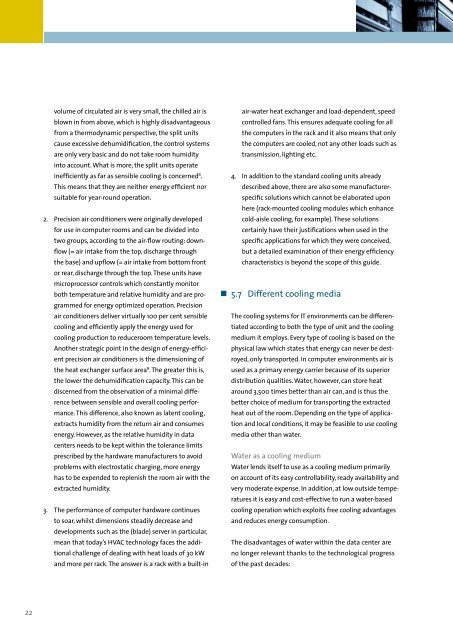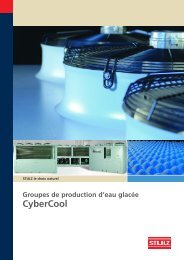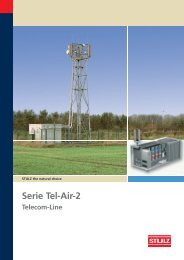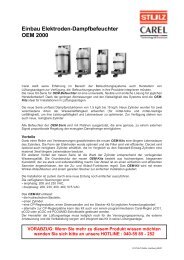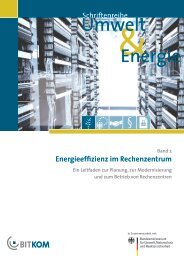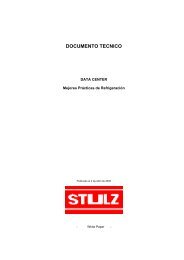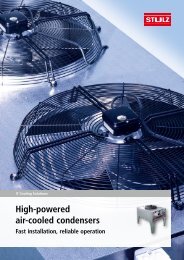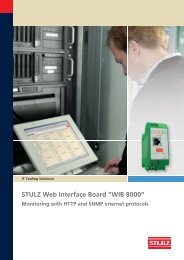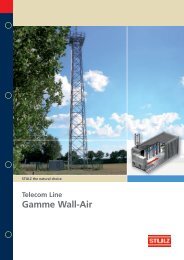Climate protection needs energy efficient data centers - Stulz GmbH
Climate protection needs energy efficient data centers - Stulz GmbH
Climate protection needs energy efficient data centers - Stulz GmbH
Create successful ePaper yourself
Turn your PDF publications into a flip-book with our unique Google optimized e-Paper software.
2.3.volume of circulated air is very small, the chilled air isblown in from above, which is highly disadvantageousfrom a thermodynamic perspective, the split unitscause excessive dehumidification, the control systemsare only very basic and do not take room humidityinto account. What is more, the split units operatein<strong>efficient</strong>ly as far as sensible cooling is concerned 8 .This means that they are neither <strong>energy</strong> <strong>efficient</strong> norsuitable for year-round operation.Precision air conditioners were originally developedfor use in computer rooms and can be divided intotwo groups, according to the air-flow routing: downflow(= air intake from the top, discharge throughthe base) and upflow (= air intake from bottom frontor rear, discharge through the top. These units havemicroprocessor controls which constantly monitorboth temperature and relative humidity and are programmedfor <strong>energy</strong> optimized operation. Precisionair conditioners deliver virtually 100 per cent sensiblecooling and <strong>efficient</strong>ly apply the <strong>energy</strong> used forcooling production to reduceroom temperature levels.Another strategic point in the design of <strong>energy</strong>-<strong>efficient</strong>precision air conditioners is the dimensioning ofthe heat exchanger surface area 9 . The greater this is,the lower the dehumidification capacity. This can bediscerned from the observation of a minimal differencebetween sensible and overall cooling performance.This difference, also known as latent cooling,extracts humidity from the return air and consumes<strong>energy</strong>. However, as the relative humidity in <strong>data</strong><strong>centers</strong> <strong>needs</strong> to be kept within the tolerance limitsprescribed by the hardware manufacturers to avoidproblems with electrostatic charging, more <strong>energy</strong>has to be expended to replenish the room air with theextracted humidity.The performance of computer hardware continuesto soar, whilst dimensions steadily decrease anddevelopments such as the (blade) server in particular,mean that today’s HVAC technology faces the additionalchallenge of dealing with heat loads of 30 kWand more per rack. The answer is a rack with a built-inair-water heat exchanger and load-dependent, speedcontrolled fans. This ensures adequate cooling for allthe computers in the rack and it also means that onlythe computers are cooled, not any other loads such astransmission, lighting etc.4. In addition to the standard cooling units alreadydescribed above, there are also some manufacturerspecificsolutions which cannot be elaborated uponhere (rack-mounted cooling modules which enhancecold-aisle cooling, for example). These solutionscertainly have their justifications when used in thespecific applications for which they were conceived,but a detailed examination of their <strong>energy</strong> efficiencycharacteristics is beyond the scope of this guide.• 5.7 Different cooling mediaThe cooling systems for IT environments can be differentiatedaccording to both the type of unit and the coolingmedium it employs. Every type of cooling is based on thephysical law which states that <strong>energy</strong> can never be destroyed,only transported. In computer environments air isused as a primary <strong>energy</strong> carrier because of its superiordistribution qualities. Water, however, can store heataround 3,500 times better than air can, and is thus thebetter choice of medium for transporting the extractedheat out of the room. Depending on the type of applicationand local conditions, it may be feasible to use coolingmedia other than water.Water as a cooling mediumWater lends itself to use as a cooling medium primarilyon account of its easy controllability, ready availability andvery moderate expense. In addition, at low outside temperaturesit is easy and cost-effective to run a water-basedcooling operation which exploits free cooling advantagesand reduces <strong>energy</strong> consumption.The disadvantages of water within the <strong>data</strong> center areno longer relevant thanks to the technological progressof the past decades:22


